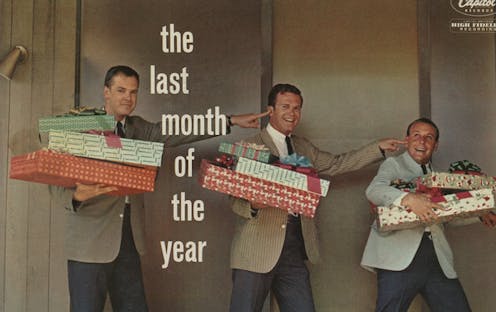The Christmas album that heralded the end of a folk musical era: The Kingston Trio’s The Last Month of the Year
- Written by Kit MacFarlane, Lecturer, Creative Writing and Literature, University of South Australia

For those looking to introduce some musical conflict into the holidays, Bob Dylan’s Christmas in the Heart remains a great choice in its 15th anniversary – like it or not.
Before Dylan really got started, an iconic group opened the door to mainstream folk success for Dylan and his contemporaries. And at the height of their popularity, they also released an unexpected Christmas album.
But instead of becoming a perennial classic, it seemed to foreshadow the approaching end for the group’s dominance at the peak of popular music.
That album was The Kingston Trio’s ill-fated The Last Month of the Year from 1960.
The ‘hottest act in show business’
The Kingston Trio are often remembered as a clean-cut, sanitised and goofy footnote in musical history. Their matching striped shirts may be a difficult fashion choice to rehabilitate today, but the trio’s impact on popular music was explosive.
Popular performances in 1957 San Francisco led quickly to their self-titled first album the following year. Reshaping folk music for a mainstream audience energised professional and amateur performers.
Critic Greil Marcus describes their breakthrough hit, 1958’s Tom Dooley, as having “the same effect on hearts and minds in 1958 that Nirvana’s Smells Like Teen Spirit and Nevermind did in 1991”.
By the time they released their Christmas album, they were the “hottest act in show business”.
In the previous two years, they’d had five number one albums on the Billboard charts. Four of their albums were in the top ten at the same time. They reportedly generated 15% of Capitol Records’ annual sales.
Following that phenomenal success, one early response to their Christmas album noted:
By now it’s fairly well established that the Kingston Trio could record Row, Row Your Boat in 12 languages, put it on wax, and the album would sell a half-million copies. As a consequence, there’s little doubt that The Last Month of the Year will be one of the big sellers this Christmas.
Instead, The Last Month of the Year became their first studio album not to reach number one.
Although still successful, their later albums never reached number one or Gold Album status again. Founding member Dave Guard left in 1961. A new lineup with replacement John Stewart had peaks of success, enduring in a changing folk scene – but never quite recapturing those initial years.
‘Perhaps the most unusual set of the year’
The Kingston Trio were lambasted, then and now, for their commercial focus. Nevertheless, The Last Month of the Year stands in contrast to many enduring commercial norms.
Contemporary responses to The Last Month of the Year noted “a number of almost unknown Christmas songs instead of the usual diet of standard carols” and “perhaps the most unusual set of the year”.
There are none of the 1940s and 1950s staples that have persisted through the decades. Nat King Cole opened his 1960 album The Magic of Christmas with a spirited Deck the Halls. Both Ella Fitzgerald (on Ella Wishes You a Swinging Christmas) and Peggy Lee (on Christmas Carousel) opened their Christmas albums of the same year with Jingle Bells.
In contrast, The Kingston Trio’s opening track is a subdued version of the 16th century Coventry Carol, a lullaby for the children Herod ordered to be killed. The restrained use of a celeste, or bell-piano, summons Christmas vibes but largely augments the sombre harmonies.
Opening with the biblical Massacre of the Innocents was certainly one way to set The Last Month of the Year apart from its jolly competitors.
Range, energy and appropriation
Other songs include delicate folk (All Through the Night), traditional rounds (A Round About Christmas), historical carols (Sing We Noel) and uncharacteristic original lyrics (The White Snows of Winter).
Spirituals Go Where I Send Thee and The Last Month of the Year (What Month Was Jesus Born In) allow the trio to focus on the kind of energy (and appropriation) that had defined much of their previous output.
Goodnight My Baby charms as a Christmas Eve lullaby that’s too excited to lull anyone to sleep.
Adding oddness, Mary Mild reshapes the strange apocryphal The Bitter Withy where a child Jesus creates “a bridge of the beams of the sun” to encourage children to play with him. The Kingston Trio only hint at the song’s common outcome that leaves his playmates dead and Mary meting out some corporal punishment.
Perhaps more restrained than their usual performances, the album nevertheless guides listeners through some of the styles and sources that the Trio’s brand of popular folk could draw on.
A Christmas album that still has something to offer
The Last Month of the year wasn’t the cause, but it occupies a turning point where The Kingston Trio’s cultural dominance began to slip.
Soon after, Bob Dylan’s song Blowin’ in the Wind (published in 1962) and album The Freewheelin’ Bob Dylan (1963) marked a new era of folk that revived its political energy (for a while).
As folk music further solidified its place in the civil rights movement, the Kingston Trio’s collegiate party vibes and perceived apoliticism seemed out of step.
When Dylan released his Christmas album in 2009, one critic asked “Is he sincere? Does he mean it?”
That’s also a question that defined and dogged The Kingston Trio from the outset of the folk revival they ushered in. Are these goofy guys serious?
The Last Month of the Year is an intriguing and ambitious album by a group that, for a short but influential time, reshaped popular music.
It’s a forgotten Christmas album that might still have something new to offer a Christmas-weary listener.
Authors: Kit MacFarlane, Lecturer, Creative Writing and Literature, University of South Australia



